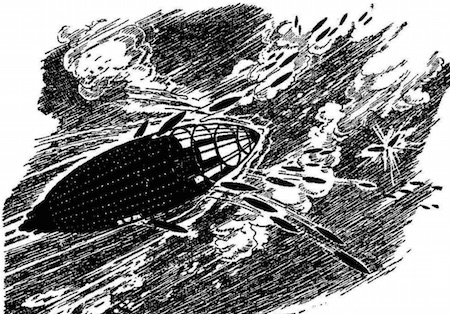Science Fiction
Dictionary
A B C D E F G H I J K L M N O P Q R S T U V W X Y Z
Latest By
Category:
Armor
Artificial
Intelligence
Biology
Clothing
Communication
Computers
Culture
Data Storage
Displays
Engineering
Entertainment
Food
Input Devices
Lifestyle
Living Space
Manufacturing
Material
Media
Medical
Miscellaneous
Robotics
Security
Space Tech
Spacecraft
Surveillance
Transportation
Travel
Vehicle
Virtual
Person
Warfare
Weapon
Work
"I think engineering will supply our demand for a "spiritual" life after meat death."
- Bart Kosko
| Deceleration Chambers | ||
| Stressed, the ship breaks apart into parts that may survive. |
| Striking that mass of gas at half a light year a minute was like running into an unending solid wall. The great ship shuddered in every plate as the deceleration tore at her gigantic strength. In seconds she had run the gamut of all the recoil systems her designers had planned for her as a unit. She began to break up.
 (Deceleration chambers from 'The Storm' by A.E. van Vogt)
And still everything was according to the original purpose of the superb engineering firm that had built her. The limit of unit strain reached, she dissolved into her nine thousand separate sections. Streamlined needles of metal were those sections, four hundred feet long, forty feet wide; sliverlike shapes that sinuated cunningly through the gases, letting the pressure of them slide off their smooth hides. |
| Technovelgy from The Storm,
by A.E. van Vogt. Published by Astounding Science Fiction in 1943 Additional resources -
|
Compare to the lifeboat from Spacehounds of IPC (1931) by 'Doc' Smith, the escapecraft from The Ethical Equations (1945) by Murray Leinster, the emergency space-boat from Revolt of the Star Men (1932) by Raymond Z. Gallun, the manshell from Sunward Flight (1943) by Leo Zagat, the escape pod from Star Wars (1976) by George Lucas, the survival bubble from Footfall (1985) by Niven & Pournelle, the life ship from The Invisible World by Ed Earl Repp, the deceleration chambers from The Storm (1943) by AE van Vogt and the emergency lifeboats from Triplanetary (1934) by 'Doc' Smith.
Comment/Join this discussion ( 0 ) | RSS/XML | Blog This |
Additional
resources:
More Ideas
and Technology from The Storm
More Ideas
and Technology by A.E. van Vogt
Tech news articles related to The Storm
Tech news articles related to works by A.E. van Vogt
| Will Space Stations Have Large Interior Spaces Again? |
| Reflect Orbital Offers 'Sunlight on Demand' And Light Pollution |
| Chrysalis Generation Ship to Alpha Centauri |
| The First Space Warship For Space Force |
Want to Contribute an
Item?
It's easy:
Get the name of the item, a
quote, the book's name and the author's name, and Add
it here.
| <Previous | Next> |
|
|
|
Technovelgy (that's tech-novel-gee!) is devoted to the creative science inventions and ideas of sf authors. Look for the Invention Category that interests you, the Glossary, the Science Fiction Invention Timeline, or see what's New.
|
Science Fiction
Timeline
1600-1899
1900-1939
1940's 1950's
1960's 1970's
1980's 1990's
2000's 2010's
'Power could be compressed thus into an inch-square cube of what looked like blue-white ice'
'It's so light that you can set it up in five minutes by yourself...'
'Heavy penalties... were to be applied to any one found driving manually-controlled machines.'
'Buy a Little Dingbat... electropen, wrist watch, pocketphone, pocket radio, billfold ... all in one.'
'... an elastic, tinted material that had all the feel and appearance of human flesh and epidermis.'
'It is remarkable that the long leverages of their machines are in most cases actuated by a sort of sham musculature...'
